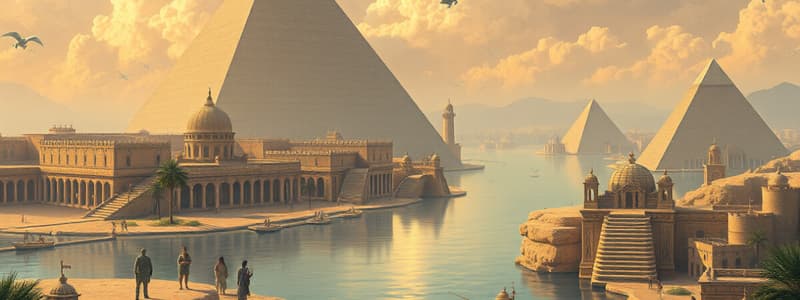Podcast
Questions and Answers
Ancient Egypt stood as one of history’s most powerful ______ for more than 3,000 years.
Ancient Egypt stood as one of history’s most powerful ______ for more than 3,000 years.
empires
The ancient Egyptians are most known for their ______, tombs, and mausoleums.
The ancient Egyptians are most known for their ______, tombs, and mausoleums.
pyramids
The cubit was a key measure used in designing the ______ and other structures.
The cubit was a key measure used in designing the ______ and other structures.
pyramids
Ancient Egyptians established the ______ writing system, followed by a system that used ink on papyrus paper.
Ancient Egyptians established the ______ writing system, followed by a system that used ink on papyrus paper.
The civilization of ancient Egypt came to an end in ______ B.C. when it was conquered by Alexander the Great.
The civilization of ancient Egypt came to an end in ______ B.C. when it was conquered by Alexander the Great.
Flashcards are hidden until you start studying
Study Notes
Ancient Egypt Overview
- Ancient Egypt was one of the most powerful civilizations, thriving for over 3,000 years.
- The civilization flourished along the fertile banks of the Nile River, extending from modern-day Syria to Sudan.
Key Achievements
- Renowned for monumental architecture including pyramids, tombs, and mausoleums.
- Mummification practices were developed to prepare the deceased for the afterlife.
- Skilled labor capable of assembling vast projects, exemplified by the Great Pyramid's construction, which involved 100,000 workers in 2600 B.C.
Agriculture and Medicine
- Egyptians excelled in agriculture, utilizing the Nile for irrigation and food production.
- Advanced medical knowledge contributed to their reputation for health and healing.
Artistic Contributions
- Developed distinct sculpture and painting traditions showcasing their artistic talents.
- Their art often had religious and cultural significance, reflecting their beliefs and societal values.
Writing and Mathematics
- Established a sophisticated writing system known as hieroglyphics, used for monumental inscriptions and administrative purposes.
- Created a 24-hour day and a 365-day calendar, laying groundwork for future timekeeping systems.
- The cubit, a measurement derived from the length of the forearm, was essential for the design of large structures.
Decline of Civilization
- The civilization faced its end in 332 B.C., when conquered by Alexander the Great, marking a significant turning point in its history.
Studying That Suits You
Use AI to generate personalized quizzes and flashcards to suit your learning preferences.




